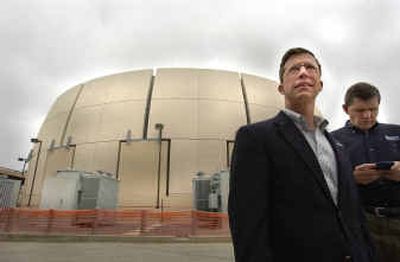High-tech buildings compute to low costs

At Dallas/Fort Worth Airport, the lights are controlled by sensors that measure sunlight. They dim immediately when it’s sunny and brighten when a passing cloud blocks the sun.
At a new middle school in Washington, D.C., the air conditioner shuts off when a window is open.
A wall of windows at a University of Pennsylvania engineering building has built-in blinds adjusted by a computer program that tracks the sun’s path.
Buildings are getting smarter — and the next generation of building materials is expected to do even more.
Windows could trap the sun’s energy to heat water. Sensors that measure the carbon dioxide exhaled by people in a room could determine whether the air conditioning needs to be turned up.
“More potential products have been invented in the last 15 years than in the entire prior history of architecture,” says Philadelphia architect Stephen Kieran. “We’re only beginning to tap the potential of those materials.”
The new materials and technology are being used in a wave of buildings designed to save as much energy as possible. They range from old ideas, like “green roofs,” where a layer of plants on a roof helps the building retain heat in winter and stay cool in summer, and new ideas, like special coating for windows that let’s light in, but keeps heat out.
Many new building materials are first developed in Europe, where energy is more expensive. “The construction industry is behind the times in some ways, compared to many other industries,” said Patrick Mays, chief information officer of architecture firm NBBJ.
Smart building technology in the United States was formerly reserved for large projects and college campuses.
“Now we’re seeing it make its way down, even to the residential market,” said Jim Jones, an architecture professor at Virginia Tech. Think of the motion-sensing lights common outside garages and front doors.
As technologies such as sensors become cheaper, their uses spread.
The elevators at Seven World Trade Center, which is under construction at New York’s ground zero, will feature a dispatch system that groups people traveling to nearby floors into the same elevator, thereby saving elevator stops and trips. People who work in the building will enter it by swiping ID cards that will tell the elevators their floor; readouts will then tell them which elevator to use.
The building also has windows with a coating that blocks heat while letting in light.
More sophisticated building materials are in development. Architect Stephen Kieran’s firm is working on “smart wrap” that uses tiny solar collectors to trap the sun’s energy and transmitters the width of a human hair to move it.
“The materials in smart wrap are either commercially available or they’ve been developed in corporate or university research labs,” said Kieran, a partner at Kieran Timberlake in Philadelphia. “They’re poised to change the face of the construction industry in the next decade or so.”
Still, relatively cheap energy costs in the United States mean most building owners remain unconcerned with efficiency, said Srinivas Katipamula, a research engineer at Pacific Northwest National Laboratory. Of the roughly 4.7 million commercial buildings in the United States, only 10 percent have energy management systems or time clocks that turn lights on or off based on the time of day, he said.
Carlton Brown, chief operating officer of building developer Full Spectrum, is finishing a smart 128-unit condo project in New York City’s Harlem neighborhood that took more than five years to get off the ground.
“We were talking about a green building and a smart building and people were not really interested,” he said. Full Spectrum is finishing the project, which includes wireless broadband in every unit and washing machines that can be reserved via the Internet.
Interest in smart, energy-efficient buildings is growing, especially among those who manage large facilities, such as airports, and buildings that traditionally use lots of energy, such as laboratories.
That’s because “the operating costs of a building in its lifetime can be hundreds of times more expensive than the building was in the first place,” said Doug Lockhart, who until recently worked as energy manager for Lawrence Berkeley National Laboratory.
A new building at the Natural Energy Laboratory of Hawaii will be a “net zero energy building,” using no energy from the electric grid. The building will be cooled with piped-in 43 degrees Fahrenheit sea water and the condensation on the pipes will be used for irrigation.
New systems use energy when it’s cheapest.
The Dallas/Fort Worth Airport installed a 6 million gallon thermal storage tank that lets the airport chill air conditioner coolant in the middle of the night, when energy is cheapest, for use during the day, when energy is more expensive. This has cut cooling costs by 91 percent during periods of peak electrical demand.
“This saves real money while we use less resources and pollute less,” said Jim Crites, executive vice president of operations at the airport.
Gray-water systems, which recycle water from sinks and showers, were once largely the province of hippies.
But President Bush’s ranch in Crawford, Texas, has such systems, as will The Bank of America Tower at One Bryant Park in New York, a 54-story building being developed by the Durst Organization.
Douglas and Jody Durst, co-presidents of the company, said they first became interested in environmentally conscious building when they worked on energy-saving retrofits to their older buildings during the 1970s.
“We realized there was a better way to build them from the start,” Douglas Durst said.